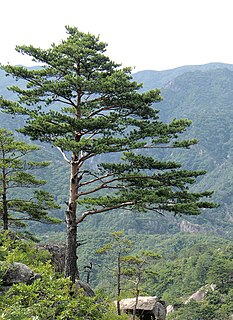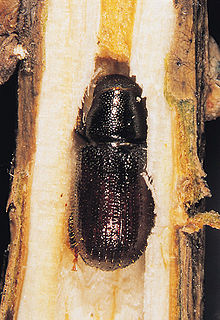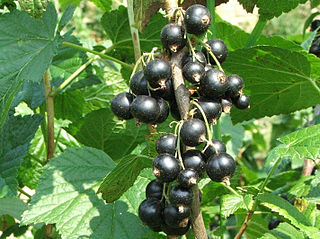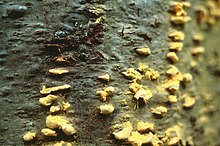
A pine is any conifer in the genus Pinus of the family Pinaceae. Pinus is the sole genus in the subfamily Pinoideae. The Plant List compiled by the Royal Botanic Gardens, Kew and Missouri Botanical Garden accepts 126 species names of pines as current, together with 35 unresolved species and many more synonyms. Pine may also refer to the lumber derived from pine trees; pine is one of the more extensively used types of wood used as lumber.
A heteroecious parasite is one that requires at least two hosts. The primary host is the host in which the parasite spends its adult life; the other is the secondary host. Both the primary host and an unrelated alternate host are required for the parasite to complete its life cycle. This can be contrasted with an autoecious parasite which can complete its life cycle on a single host species. Many rust fungi have heteroecious life cycles:

Rusts are plant diseases caused by pathogenic fungi of the order Pucciniales.

Clark's nutcracker, sometimes referred to as Clark's crow or woodpecker crow, is a passerine bird in the family Corvidae, native to the mountains of western North America. The nutcracker is an omnivore but subsists mainly on pine nuts, burying seeds in the ground in the summer and then retrieving them in the winter by memory.

Pinus albicaulis, known by the common names whitebark pine, white bark pine, white pine, pitch pine, scrub pine, and creeping pine, is a conifer tree native to the mountains of the western United States and Canada, specifically subalpine areas of the Sierra Nevada, Cascade Range, Pacific Coast Ranges, and Rocky Mountains from Wyoming northwards. It shares the common name "creeping pine" with several other plants.

Western white pine also called silver pine, and California mountain pine, in the family Pinaceae, is a species of pine that occurs in the mountains of the western United States and Canada, specifically the Sierra Nevada, the Cascade Range, the Coast Range, and the northern Rocky Mountains. The tree extends down to sea level in many areas, particularly in Oregon and Washington. It is the state tree of Idaho, and is sometimes known as the Idaho pine.

Pinus peuce is a species of pine native to the mountains of Macedonia, Bulgaria, Albania, Montenegro, Kosovo, the extreme southwest of Serbia, and the extreme north of Greece, growing typically at (600-) 1,000-2,200 (-2,300) m altitude. It often reaches the alpine tree line in this area. The mature size is up to 35–40 m height, and 1.5 m trunk diameter.

Pinus flexilis, the limber pine, is a species of pine tree-the family Pinaceae that occurs in the mountains of the Western United States, Mexico, and Canada. It is also called Rocky Mountain white pine.

Pinus strobus, commonly denominated the eastern white pine, northern white pine, white pine, Weymouth pine (British), and soft pine is a large pine native to eastern North America. It occurs from Newfoundland, Canada west through the Great Lakes region to southeastern Manitoba and Minnesota, United States, and south along the Appalachian Mountains and upper Piedmont to northernmost Georgia and perhaps very rarely in some of the higher elevations in northeastern Alabama. It is considered rare in Indiana.

Pinus ponderosa, commonly known as the ponderosa pine, bull pine, blackjack pine, western yellow-pine, or filipinus pine is a very large pine tree species of variable habitat native to mountainous regions of western North America. It is the most widely distributed pine species in North America.

Pinus cembra, also known as Swiss pine, Swiss stone pine or Arolla pine or Austrian stone pine or just Stone pine, is a species of pine tree that grows in the Alps and Carpathian Mountains of central Europe, in Poland, Switzerland, France, Italy, Austria, Germany, Slovenia, Slovakia, Ukraine and Romania. It typically grows at 1,200 metres (3,900 ft) to 2,300 metres (7,500 ft) altitude. It often reaches the alpine tree line in this area. The mature size is typically between 25 metres (82 ft) and 35 metres (115 ft) in height, and the trunk diameter can be up to 1.5 metres (4.9 ft). In its natural environment, this tree usually reaches reproductive maturity at the age of 50 years. The species is long-lasting and can reach an age between 500 and 1000 years. However, it grows very slowly and it may take 30 years for the tree to reach 1.3 metres (4.3 ft).

Pinus sibirica, or Siberian pine, in the family Pinaceae is a species of pine tree that occurs in Siberia from 58°E in the Ural Mountains east to 126°E in the Stanovoy Range in southern Sakha Republic, and from Igarka at 68°N in the lower Yenisei valley, south to 45°N in central Mongolia.

Cronartium ribicola is a species of rust fungus in the family Cronartiaceae that causes the disease white pine blister rust. Other names include: Rouille vesiculeus a cinq feuilles pin (French), white pine Blasenroste (German), moho ampolla del pino blanco (Spanish).

Comandra is a monotypic genus containing the single species Comandra umbellata. Its common names include bastard toadflax, umbellate bastard toadflax, and common comandra. The plant has a disjunct distribution; its four subspecies occur in North America and the Mediterranean.

Tomicus piniperda is a bark beetle native throughout Europe, northwestern Africa, and northern Asia. It is one of the most destructive shoot-feeding species in northern Europe.

Lophodermium is a genus of fungi within the family Rhytismataceae. The genus contains 145 species and has a global distribution. Species of this genus are usually observed producing zone lines, conidiomata and ascomata on dead fallen leaves, but at least some are known to colonize living leaves. In many cases they then live inside the colonized leaf as a symptomless endobiont, where they are regarded as detritivores utilising dead plant matter. In a few cases they may kill all or part of the leaf prematurely, and there is a substantial literature dealing with those species as plant pathogens. The genus infects many different plant families but with a notable concentration in the family Pinaceae; many Lophodermium species are restricted to a single host genus, but some, particularly those infecting grasses, may infect several genera. Some are economically important plant pathogens, such as those that cause needlecast disease in European Black Pine, Scots Pine and Red Pine in forestry and christmas tree plantations. In these species, notably L. pinastri and L. seditiosum, the fungal spores disperse and infect the pine needles in late summer, which turn brown by the following spring and then fall off.

Suillus placidus, is a species of fungus in the genus Suillus. It is an edible pored mushroom found in European and North American coniferous forests, growing in association with several species of pine of the subgenus Strobus.
Annie Gravatt was an American forest pathologist. Her areas of research included plant physiology and white pine blister rust. She also studied Chestnut blight, the fungus that devastated American chestnut trees in the early 20th century. Along with her husband, George Gravatt, she founded the community of Scientists' Cliffs, Maryland.

Blackcurrant production in the United States is relatively limited. The plant was introduced by English settlers at the Massachusetts Bay Colony in 1629 and was cultivated on some scale, particularly in New York. The plant acts as a host for the white pine blister rust that threatened the timber industry. In 1911, the Federal government banned the cultivation, sale and transport of blackcurrants to protect the white pine. Government programs systematically destroyed blackcurrant plants by chemical spraying.

















